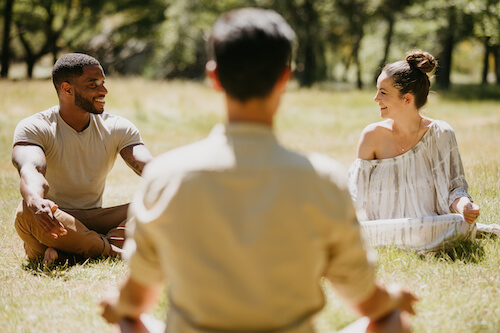Setting Boundaries – The GPS for Successful Relationships

© New Life Portugal
“Relationships are one of the trickiest aspects of being human,” said our Counsellor Simone da Costa in our morning community meeting this week here at New Life Portugal. As humans we are naturally social beings, even if we tend to be more introverted, most of us can’t avoid having some kind of human interaction in our daily life.
We hear sweeping statements like “relationships are the most important thing in life” or “relationships are the key to happiness”. Being of such high value and importance to us, it’s no wonder that they are also one of our biggest sources of stress and suffering.
From our most intimate relationships with our partners, family, friends, colleagues, to the more fleeting interactions with a customer service assistant on the phone, so often our experience with others can somehow leave us feeling frustrated, unsatisfied, and even seriously stressed and depressed. So how can we demystify the art of successful relationships?
Why pairing the topic of relationships with boundaries?
A great starting point to navigate the mangled highways of our many human interactions, is to have a good ‘Relationship GPS’, and that’s where boundaries come in. They are one of the most useful tools at our disposal to develop a much better relationship with relationships. By bringing awareness and intention to your boundaries, you step into the driving seat and start to direct your life experience towards what it is you really want.
Here are some different types of boundaries you could think about setting, and how they might be useful.
Inner boundaries
We cannot always control the circumstances in our lives, or the behavior of others. What we do have autonomy over, however, is how we act and respond, both externally and internally. When we bring our awareness to the thoughts and feelings we want to have, it helps us to pinpoint where our inner boundaries are. For example:
- I want to experience more appreciation than disappointment.
- I want to feel more ease than frustration.
- I love and value myself.
- I want to feel more freedom and joy.
- I want to experience more connection and compassion in my relationships.
Practice:
Write a list of qualities you want to experience in your inner world to use as your inner GPS. It can be anything that feels important to you, something you want to experience or feel.
Having these positive inner boundaries, means you can encounter any situation, already knowing the direction you want to go. They help you to navigate from veering off into unwanted thoughts and feelings and guide you back into your own lane.
Try it out, any time you notice you have gone off course and are feeling something uncomfortable, bring your attention back to your inner boundaries and notice how they bring you back into alignment.
External boundaries
Sometimes knowing your inner boundaries, can also help to define your external boundaries. These can be anything from choosing how much time to spend with someone, or on a particular activity, to identifying behaviours in relationships that you will or will not accept.
Practice:
List of five external boundaries you could set right now, to bring you back into alignment with your inner sat nav.
Here’s some examples:
- I’m going stop ironing the bed sheets and instead spend two hours a week with my family doing something fun.
- I will no longer work extra hours without being paid.
- I’m not going to visit my parents every evening, as I need a little more time to do other things.
There are many possibilities of external boundaries that might feel good for you. Notice how good it actually feels to set them! There is relief and freedom in knowing and defining what you do and don’t want.
When we identify and articulate our boundaries, not only are we saying a loving yes to ourselves, but we are also clearly letting others know how they can relate to us, and where our yes is! It’s unlikely anyone is going to complain about crumpled bed sheets when they get to do fun things with you instead. It’s more likely that they will feel happy you set that boundary for yourself; and them.

Notice how this enquiry into your own boundaries makes you more curious about getting to know what boundaries other people in your life may have, and how understanding them might make relating with them much less of a mystery!
Practice the art of saying ‘No’
So by now you understand that the value of saying ‘no’ is that on the flip side, is always a loving yes and an invitation to something else we value. However, saying no can bring up all sorts of uncomfortable feelings like, guilt or fear, which makes it really tricky to do, so here are some tips for mastering the art of saying no.
Speak authentically from the ‘I’
This means speaking about yourself and how you are feeling, and trying not to blame or criticise other people. For example, you could say to your partner “I am feeling really exhausted, I know it’s not your fault, I’ve taken on too much, and you do so much too, but I need to find a better balance, can you help me figure this out?” Most people will react well if they can sense your genuine feelings and don’t feel attacked.
Be inclusive and curious
Whenever you communicate something that changes the status quo in a relationship, remember to be open and curious about how it impacts the other. You don’t need to compromise the boundary you have set. The idea is that you remain open to an inclusive conversation, which will go a long way to softening your ‘no’. Who knows, maybe there is some movement that becomes possible and feels good to both of you.
Emphasise your yes
Remember the positive ‘yes’ on the other side of the boundary you are setting, and share it. Often there will be a beneficial outcome for the other person from you putting this boundary in place. Even if it is just that they get to experience a happier version of you. Sharing something positive may help them to accept the change you are communicating.
Be understanding but not apologetic
We often tend to start by saying something like “I’m sorry, but…”
Whether it’s out of politeness or guilt, but it is important to learn to say no, without apologising because it devalues you and what is important to you. We are all equally important and you have every right to say no without condition. Try saying something like “I understand” instead.
Practice:
Prepare for one of the ‘No’ conversations you would like to have using these tips. Notice how you already feel more relaxed and confident in yourself.




